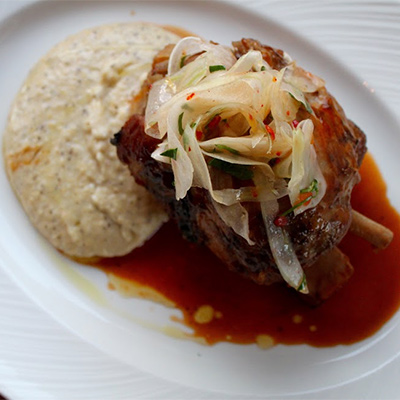High-Gloss Rustic: A Mano Reviewed

A Mano | Photo by Emily Teel
In the back, chef Michael Millon is dancing.
Not dancing-dancing (because that would be weird), but that’s what it looks like. He and his crew, the other white jackets working the line at Townsend Wentz’s new BYO, A Mano, turn and weave around each other, reaching and ducking as the floor staff crowds up against the short pass, waiting on plate after plate after plate. It’s formal, this ballet. It only looks like a disaster happening and then re-happening every second, a series of near-misses and almost-collisions. It’s a culinary galliard—chaotic but measured. Practiced. Natural. In reality, it’s just another day at the office.
And at A Mano, it’s loud in the dining room. I’m seated about halfway down the banquette that runs the length of the far wall, so there’s no way I would’ve heard them if they were talking anyway, but I’m watching pretty closely (staring, really), and I don’t even see them speak. Don’t see lips moving or heads turning except in the simplest, most terse nods and single syllables.
They’re in the zone, these cooks. Not in the weeds, because that implies a sense of being overwhelmed. Being “in the weeds” is an insult (or was)—something you accused some other cook of being, some cherry, some rookie—but became, somehow, just a synonym for “busy.” Which, of course, A Mano is. All the time. Every night. But these guys—Millon and his crew—are on top of it, knocking out plates of restrained, highly controlled, magazine-beautiful Italian food for a forever-turning 48-seat dining room, burning through 50 or a hundred covers a night, three courses each (give or take).
And as I sit there, at a polished wood table in the spare, simple dining room, I’m the beneficiary of all this expertise—of the high-pressure magic that happens in the middle of nights like this one, when every table is full and everyone is happy and sharing space with 48 people in Fairmount can make you feel like you’re in the middle of something important or, at the very least, new.
I’m just finishing a shallow bowl of braised honeycomb tripe—chewy, dressed in a rich tomato gravy that mutes the gaminess of the tripe itself, punctuated with the nuttiness of chickpeas and crisp bits of guanciale—that’s more artful and considered than any tripe I’ve had before. It’s followed by the potato-and-goat-cheese gnocchi (one of the stars of A Mano’s menu, even if it’s not the best of the primi courses)—little pillow-soft lumps of slightly sour pasta, each the size of the first knuckle of my thumb, resting in a puddle of impossibly green basil sauce scattered with English peas, pea shoots, and shards of crispy speck that lend a necessary note of salt and crunch and pointiness to all this lush spring softness and pliability. It’s delicious (of course) and so easy to eat that were I without manners and given a large enough spoon, I could finish the whole plate in two bites while barely even needing to chew.
The pan-seared branzino over baby turnips with ’nduja vinaigrette seems more like a punishment than dinner—like being forced to eat a bad joke about modern chef-y cuisine—and yet it works, because the kitchen gentled and coddled every element of it, lavishing attention on a fish that I’d pretty much given up on after spending the winter eating mediocre preparations of it and then topping it (simply, spectacularly) with a salmoriglio sauce that’s nothing but lemon, olive oil, garlic and parsley. The ’nduja sausage got turned into a vinaigrette by thinning it and whipping it into a smooth puree (which, yes, is kind of like serving a plate decorated with a spicy liverwurst mojo, but whatever), and the baby turnips were still essentially turnips, but there was an elemental core to the dish that was awesome in its simplicity (fish, lemon, garlic) and exemplary care of the ingredients. The food hipsters at the table next to mine had ordered the branzino, too. They (loudly) loved it, praised the complexity, took photos, shared forkfuls with each other, and asked many insightful questions about the ’nduja vinaigrette.
They left most of the turnips behind, too.

Pork shank at A Mano | Photo by Emily Teel
The pork shank is better. The size of a fist with the wrist bones still sticking out, it’s balanced on a plate with a mound of taleggio polenta to one side, wearing an impressive hat made of pickled fennel ribbons. I’m sure it’s meant to look all rustica with its bones and meat-fist and pilacca hot pepper sauce drizzled off to the side, but there’s no doubt the kitchen took great care in the placement of the fennel. In making it look just so.
On other nights (amid other full-house crowds), I eat the shank prefaced with a bowl of roasted cauliflower florets, because I’m a sucker for cauliflower in almost all its forms (which is nice because cauliflower has been on every menu in town for months). I love it in this specific one: tossed with golden raisins, tiny pine nuts and chopped mint, all spiked with a Calabrian chili vinaigrette powerful enough to assert itself (politely) over the woodiness and big blandness of the cauliflower itself. I eat cavatelli pasta, perfectly al dente, rolled in a sauce green with parsley and mounted with bone marrow for an almost otherworldly richness and smoothness. There’s green garlic in there, and tiny white beech mushrooms, and fat escargots that remind me how excellent snails are with a simple, bright, buttery pasta and how almost no one does that anymore. When that’s all gone, I tear off hunks of the kitchen’s homemade focaccia and run them through the sauce—finding, finally, in the odd intersection between rough-edged Italian and meticulous French techniques, a fullness in A Mano that in many other ways was lacking.
A Mano is, in many ways, a poor man’s Vetri—and I mean that in the best possible way. It’s BYO. They take no reservations (an answer from chef-owner Townsend Wentz to the complaints that tables are so tough to get at his less-new French restaurant, Townsend, on East Passyunk). It’s cash-only, and tops out at $29 for the braised short rib, but a hungry man can get out the door for around $50, pre-tip, with three courses under his belt (which I know because I did it). The room is simple, almost empty but for the tables, the people, the food, and the service is casual, but the style and quality of the plates are right up there among the best high-end Italian in this town.
Which, weirdly, is my one true problem with the place. There’s a part of me that believes Italian food never should have risen to the level of fine dining—that the messy plate of spaghetti and meatballs on a red-and-white-checked tablecloth is the finest expression of what Italian cuisine ought to be. In the moment, though—sitting in that plain room, with every sense focused intently on the food in front of me—I love it all. A Mano’s food is intelligent and restrained, delicious (obviously), gorgeous (obviously), cultured and fastidious almost (but not quite) to the point of fussiness. These are plates that show off every skill present in the kitchen, packed with deeply complex flavors and curated ingredients. But there’s also (with the exception of that cavatelli with escargots) a hollowness at the center of many of them. An empty space where the comfort and joy of spaghetti and meatballs ought to go. I love A Mano while I’m there, but as I walk out the door, I immediately begin to question myself. Did I really like it that much?, that soft voice inside me asks.
To which a much louder (and maybe smarter) voice answers, Of course you did, dummy, then beats up that traditionalist part of me and steals its lunch money. Because how could I not like it? The moment is what matters, isn’t it? And besides, fussiness, complication, hipster-baiting and turnips are the price (beyond cash, naturally) that one pays for the experience of eating at the rarified edges of cuisine. Despite the plain room and the wine totes under every table, no one is going to mistake A Mano for some simple little neighborhood trattoria. It’s a place where Italian cuisine is buffed and polished to a high sheen; where rusticity and hominess are used like garnishes—they exist in the conception of each dish, if not always in the execution. If the dishes feel sometimes brittle in their reach for perfection, that’s because perfection is a thin layer above simply great. The slightest wobble can shatter it. Reaching for it is a dangerous game.
And yet that’s what Millon and his crew are doing as they waltz through busy night after busy night. So if that’s your thing (and trust me, sometimes it’s absolutely my thing, too), you gotta get here. Take your chances with the crowds. Bring a really nice bottle (or two). And make sure your wallet is full of folding money. But get here. Because in a city as awash in red sauce as this one, watching this kitchen work and tasting the levels of refinement it’s capable of reaching is a remarkable experience.
Even if, sometimes, you walk out the door feeling a little bit cold.
3 stars – Come from anywhere in the city
A Mano [Foobooz]


